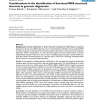85 search results - page 15 / 17 » Sequence based residue depth prediction using evolutionary i... |
BMCBI
2007
13 years 6 months ago
2007
Background: Protein remote homology detection is a central problem in computational biology. Most recent methods train support vector machines to discriminate between related and ...
IPPS
2006
IEEE
14 years 18 hour ago
2006
IEEE
—Homology modeling requires an accurate alignment between a query sequence and its homologs with known three-dimensional (3D) information. Current structural modeling techniques ...
JUCS
2010
13 years 4 months ago
2010
: When considering the prediction of a structural class for a protein as a classification problem, usually a classifier is based on a feature vector x ∈ Rn , where the features...
BMCBI
2007
13 years 6 months ago
2007
Background: Accurate identification of novel, functional noncoding (nc) RNA features in genome sequence has proven more difficult than for exons. Current algorithms identify and s...
BMCBI
2004
13 years 5 months ago
2004
Background: In a previous paper, we introduced MUSCLE, a new program for creating multiple alignments of protein sequences, giving a brief summary of the algorithm and showing MUS...

